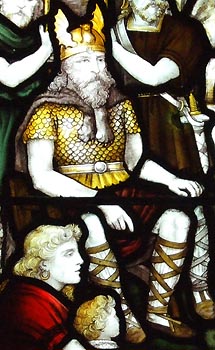 |
 |
|||
|
|
Cado appears briefly in a number of hagiographic records as the King of Dumnonia. Chief amongst these is the 'Life of St. Caronnog'. This tells how Cado and the High-King Arthur "were reigning in that country" [across the Severn from Wales, ie. in Dumnonia]. Arthur was staying with his fellow (and presumably subordinate) monarch at Din-Draithou, generally thought to be Dunster Castle in West Somerset. It was while there that St. Carannog arrived looking for his floating altar, which he had promised to follow and preach wherever it landed. Arthur would only reveal its whereabouts if Carannog would rid Dumnonia of a terrible dragon that was terrorising the people of Carrrum (Carhampton). St. Carannog quickly despatched the serpent and the High-King was forced to hand over the altar which he had been trying to use as a table. Carannog was given Carrum by the two Kings in gratitude for his efforts. According to the early Welsh genealogies, Cado had succeeded his father, Gerren Llyngesoc, as King of Dumnonia and Arthur was his maternal cousin. Apart from Din-Draithou (Dunster), he probably ruled from some of the larger strongholds of the South-West. The hillfort of South Cadbury, west of Wincanton in Somerset, may have been one. A sub-Roman (5th/6th century) gateway and large feasting hall have been excavated there. The name means either 'Battle Fort' or more simply, 'Cado's Fort', and is therefore more likely to be a palace of Cado than, as popularly held, King Arthur's Camelot. Tintagel may have been Cado's more southerly Summer residence. Cado probably died at the beginning of the 6th century. Traditionally this was at the Battle of Camlann (AD 537), after which he was said to have been buried in the Condolden (or Cadon) Barrow near Camelford in Cornwall and was succeeded by St. Constantine. Cado appears in Arthurian literary sources as Cador, Earl of Cornwall. He is first mentioned in Geoffrey of Monmouth's History of the Kings of Britain (1136) where fights alongside King Arthur against many Anglo-Saxon and other enemies, including at the famous Seige of Mount Badon. However, by 1457, his title had mistakenly transformed him into King Arthur's elder maternal half-brother, the son of Gorlois, variously called Duke of Tintagel or Earl of Cornwall. In the romance of 'Geraint ab Erbin', Cado was great friends with his brother-in-law, King Carodog Freichfras (Strong-Arm) of Gwent (Wales) & Broerec (Brittany). He was with Caradog when the latter confronted the evil wizard, Eliafres, about his parentage. Eliafres refused to answer Caradog's accusations and caused a serpent to entwine itself around the young man's arm. It took the combined strength of Cado and Caradog's first wife to remove the creature, and henceforth, poor Caradog became known as Briefbras or 'short arm'. Records of Cado date back to the 9th century. He is generally considered legendary.
|
|||
| © Nash Ford Publishing 2001. All Rights Reserved. | ||||





 Cado, King of Dumnonia
Cado, King of Dumnonia